Gradually, the small self-loading pistol has replaced the snubnose 38 Special revolver as the default carry gun for most Americans. While there are other choices, the slim-line 9mms, such as the Smith & Wesson Shield and Ruger LC9s and others, are the most-popular concealed-carry handguns in America. But despite those pistols’ popularity, companies continue to innovate, seemingly defying conventional engineering by make smaller pistols reliable and easier to shoot, while not losing a lot in round counts.
Ruger, Smith & Wesson, and Taurus have introduced pistols that are not quite slim-line nines but are a tiny bit larger. They are the Ruger MAX-9 No. 3500, Smith & Wesson M&P9 Shield Plus 13246, and the Taurus GX4 1-GX4M931.
These new-breed pistols are among the more-innovative handguns we have tested in some time. We don’t think we missed anything in testing these pistols and in the end, there is little reason to choose the slim-line nine over these handguns. They take the small 9mm from single-digit to double-digit capacity. In this matchup we fired, field stripped and carried the three similar pistols and found good performance. All received a solid A or A- ratings. There were no malfunctions. The pistols seem well thought out. But there are differences.
Here’s what we thought of them after extensive handling and range testing.
Gun Tests Grade: A (OUR PICK)
$544
When we found the first Ruger MAX-9 had arrived in our area, we counted ourselves lucky. On the other hand, we paid more than MSRP for our test gun. This is common today. Most dealers in small shops are not price gouging. Often, the gun has gone through more than the usual channels of factory to distributor to gun store. We noted that in the same showcase was a single-column magazine EC9 at $249 retail. At more than twice the price, the Ruger MAX-9 had best have something going for it. In the end, it does, and it will reward a shooter who practices with good performance. (We should mention that a month later, the price had dropped to $449 on average, and four shops in one town had the pistol.)
| Action Type | Locked breech, striker fired semi-auto |
| Overall Length | 5.95 in. |
| Height | 4.6 to 5.0 in. |
| Max Width | 1.04 in. |
| Weight Unloaded | 19.0 oz. |
| Weight Loaded | 24.0 oz. |
| Slide Material | Steel, black-oxide finish |
| Slide Retraction Effort | 14.8 lbs. |
| Receiver Material | Glass-filled nylon |
| Front Strap Height | 1.54 in. |
| Back Strap Height | 2.7 in. |
| Barrel | 3.2 in. |
| Grip Thickness Maximum | 0.95 in. |
| Grip Circumference | 5.2 in. |
| Magazines | One 10- and one 12-round |
| Rear Sight | Fixed notch |
| Front Sight | Tritium/fiber optic |
| Sight Radius | 4.2 in. |
| Trigger Pull Weight | 5.5 lbs. |
| Trigger Span | 2.5 in. |
| Safety | Trigger lever/manual safety |
| Warranty | None |
| Made In | U.S.A. |
| Telephone | (336) 949-5200 |
| Website | Ruger.com |
Ruger may not get the kudos for handling and accuracy that some makers do, but its small defense guns, 1911 handguns, and P-series handguns have been sturdy performers for many years. Ruger is a giant manufacturer and manages to keep the price down based on volume. There is nothing groundbreaking in the design of the Ruger MAX-9; it builds on solid features that have been part of the Ruger line for some time, such as the takedown process we would like to have seen changed.
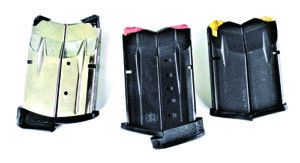
As it turns out, the Ruger MAX-9 is considerably improved over the LC9s it is descended from. But then, perhaps, it is a cut down Security 9. Let’s just let it stand on its own merits. The pistol offers a 10- or 12-round magazine and remains a light and concealable package with the extended magazine. It appears few components are shared with the LC9s or EDC, perhaps only the trigger, if that. It is difficult to re-engineer a pistol to higher capacity without also changing the grip frame and paying attention to fit and feel. High-capacity 1911 handguns have not been popular. Smith & Wesson took the nicely-shaped Model 39 9mm and gave us the Model 59, a pistol that wasn’t as well made as the Model 39 and which felt like a 2-by-4 in the hand. Here, though, both the Ruger and the Smith & Wesson Shield Plus have made a seamless and attractive transition to high capacity.
Ruger’s MAX-9 features stippling and checkering covering the handle. The grip is comfortable in the hand despite the slightly wider grip than an LC9s. The front strap is also checkered. The trigger guard is undercut slightly, which lowers the bore axis. The front of the trigger guard is serrated, a nice touch for the shooter wrapping a finger around the front of the trigger guard. While we don’t usually use this hold when one finger is dangling off the grip frame, we round this grip technique profitable. One of our raters felt that the trigger guard cramped his average-size trigger finger as he drew the gun and moved into a fast shooting position, but he was the only rater who bumped the trigger guard during the evaluation. When speed shooting, it’s better to use a crooked-finger firing position, so the trigger guard design is less relevant.
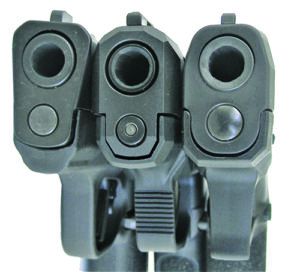
The pistol, like most others, is a locked-breech design. The grip frame is glass-reinforced nylon, sometimes referred to as Zytel. The slide is steel. The pistol is only 1.06 inches across at its widest point. The controls are a slide lock, manual safety, and magazine catch. We like the way the frame offers a wall around the controls to prevent snagging the slide lock. The new magazines are tapered stainless-steel units. One features a long base pad and holds 12 rounds; the flush-fit magazine holds 10 rounds. The slide is coated in a black-oxide finish. The barrel is 3.2 inches long. The barrel is very nicely crowned with a 45-degree cut. The pistol features forward slide serrations. The muzzle end of the slide is chamfered to allow easy holstering. When the extended magazine is in place, you may get a full firing grip. Most of us ended up with the small finger hanging off the bottom of the grip with the flush-fit magazine. An unexpected bonus is a slight grip extension that acts as magazine guide, unusual on a pistol this size. It is a trade-off of efficient magazine changes versus minimum height.
The firing mechanism differs from the common Glock or safety-action type. When the slide is racked, the striker is fully cocked and ready to fire, not “prepped” to fire. Ruger uses what it calls a rotary sear design. A similar design called the “flipping sear” was used in the Colt 1903 pistol and is regarded as a very safe design. The pistol features a bar in the trigger face to act against lateral pressure and accidental discharge, preventing trigger movement if the pistol is dropped. The finger closes on the trigger face and presses the trigger straight to the rear, releasing the striker by moving the sear down. The striker block is moved out of the way at the same time. The trigger has the longest travel of these three pistols, but it is in the middle of trigger-pull weight at 5.6 pounds. (Slightly lighter at the end of the test at 5.5 pounds.)
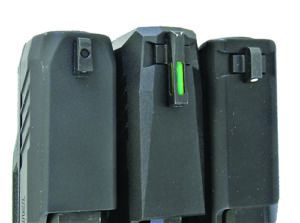
The pistol is light enough at 18.5 ounces, lighter than the Shield and about a half-ounce heavier than the Taurus. Our handgun is optics ready, with a slide cut out for mounting a red-dot sight. We did not explore this option. We like the sight configuration. The rear sight is a high-visibility type, and the front sight is a fiber optic with a tritium insert. The single tritium dot is visible in the dark and offers an advantage over the other pistols for dim-light shooting. We like the MAX’s sights the best of the three pistols tested. The front fiber optic is very fast to get on target.
The takedown process isn’t our favorite. Unload the pistol and move a tab in the frame down to allow pushing out the takedown pin. Pull the slide to the rear slightly and use a punch to press out the takedown pin. The uncocked pistol then allows the slide to run forward. The Ruger MAX-9 features a dual-spring assembly that seems to do a good job of controlling recoil. We don’t like the Ruger’s takedown sequence compared to the Shield, and the Taurus requires a screw to be turned during disassembly. The takedown-lever operation of the Shield is simpler.
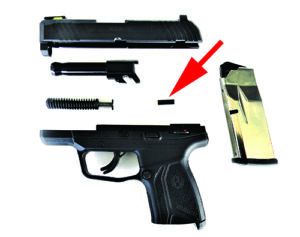
Elsewhere, we like the manual safety of the Ruger. This gives the user a greater degree of safety when carrying the pistol, and the safety is properly located on the frame for rapid manipulation. It is positive in operation. This safety locks the slide, helping prevent pushing the slide out of battery as you secure the pistol in a tightly-fitted holster.
When test firing, we try to use proven ammunition that has previously given good results. This eliminates any confusion as to whether a malfunction is ammunition or firearm related. During the pandemic panic and hoarding-driven shortage, we have been lucky to obtain enough ammunition to conduct test firing. Here, we fired 50 rounds of locally obtained C&C Indoor Range ammunition, an unknown quantity, in each pistol with good results at 7 and 10 yards in rapid combat shooting. We also fired two five-shot groups in each pistol with three types of personal-defense ammunition. These were the Black Hills Ammunition 115-grain EXP, the Federal 147-grain HST, and the Hornady American Gunner 124-grain XTP +P. Taking into consideration of the pistols’ short barrels and sight radii and their light weights, we fired groups at 15 yards.
Firing at 7 yards at a man-sized silhouette, the pistol turned in good groups. They were centered in the X ring and control wasn’t difficult. The pistol was fired from the retention position, then with one hand and both hands, and for accuracy from a benchrest. The pistol seemed to provide the best combat grouping of the test, especially because we shot a bit high with the Smith & Wesson Shield Plus until we learned to adjust our grip. We began with the safety on during all drills. The safety is easily thumbed off to fire. One of the raters forgot to move the safety to the Fire position before starting one string. This should not happen if you practice with the handgun, but just the same, some do not like a manual safety on a pistol used for personal defense. You don’t have to use it if you don’t want to.
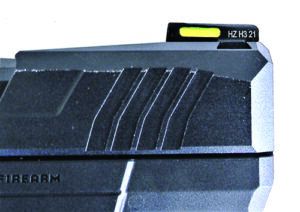
The Ruger was well regulated for 115- and 124-grain ammunition. The 147-grain load hit about a half inch to three quarters inch low in relation to the point of aim at 7 yards. We originally thought the Ruger would be the low-velocity gun of the test, but it was the fast gun with the Hornady load. Velocity variations were in the normal range for all three handguns and loads.
The pistol provided the best results of the test. Benchrest accuracy was around 2.0 inches at 15 yards, more than reasonable for a defense handgun.
Our Team Said: The Ruger MAX-9 is the largest pistol but only slightly larger than the Shield, not enough to matter in an inside the waistband holster. The Ruger and the Shield have similar performance. The Ruger was the most accurate pistol tested but barely shaded the Shield and not with every load. The Ruger features a tritium/fiber optic front sight and is optics ready while the Shield is not, making the Ruger the better buy by a considerable margin considering Ruger’s standard features. Various Shield Plus Performance Center pistols with fiber-optic sights and an optics ready slide, which we have not tested, will cost about $300 more than the version tested. The Ruger is the price beater and the overall best performer. The Ruger would be Our Pick if price were no object.
9mm Luger Range Data
| Black Hills 115-grain EXP | S&W M&P9 Shield Plus | Ruger MAX-9 | Taurus GX4 |
| Average Velocity | 1040 fps | 1060 fps | 1035 fps |
| Muzzle Energy | 276 ft.-lbs. | 287 ft.-lbs. | 274 ft.-lbs. |
| Small Group | 1.9 in. | 1.5 in. | 2.0 in. |
| Average Group | 2.4 in. | 2.0 in. | 2.5 in. |
| Hornady American Gunner 124-grain +P JHP | S&W M&P9 Shield Plus | Ruger MAX-9 | Taurus GX4 |
| Average Velocity | 1070 fps | 1084 fps | 1055 fps |
| Muzzle Energy | 315 ft.-lbs. | 324 ft.-lbs. | 306 ft.-lbs. |
| Small Group | 2.0 in. | 2.2 in. | 2.4 in. |
| Average Group | 2.5 in. | 2.6 in. | 2.8 in. |
| Federal HST 147-grain JHP | S&W M&P9 Shield Plus | Ruger MAX-9 | Taurus GX4 |
| Average Velocity | 959 fps | 928 fps | 941 fps |
| Muzzle Energy | 300 ft.-lbs. | 281 ft.-lbs. | 289 ft.-lbs. |
| Small Group | 1.9 in. | 1.5 in. | 1.9 in. |
| Average Group | 2.4 in. | 1.9 in. | 2.5 in. |
GT3 Value Guide.xlsx
| GUN NAME | ISSUE | GRADE | COMMENTS |
|---|---|---|---|
| Smith & Wesson M&P9 Shield EZ 12437 9mm Luger, $479 | Feb. 2021 | A- | The Shield EZ9 was easy to manipulate and soft to shoot, but the sights needed to be calibrated better. |
| KelTec PF9 Blued-Black 9mm Luger, $358 | Feb. 2021 | B+ | An inexpensive pistol that functioned flawlessly. It reminded us of a good 38 Special snubbie. |
| Taurus G3C 1-G3C931 9mm Luger, $306 | Feb. 2021 | B+ | Best Buy. The Taurus G3C pistol is an inexpensive offering that functioned flawlessly and shot well. |
| Springfield Armory Hellcat HC9319BOSP 9mm Luger, $550 | Mar. 2020 | A | Our Pick. An 11+1 pistol, this small Springfield might be the most versatile pistol in the group. |
| Walther PPS M2 2805961 9mm Luger, $649 | Mar. 2020 | A | Best Buy. A smaller pistol with grips that will not abrade tender hands. |
| Ruger Security-9 Compact Model 3818 9mm Luger, $309 | Feb. 2020 | B | The pistol is adequate for the task of self defense and will not break the bank. |
| SIG P365 Nitron Micro-Compact 9mm Luger, $465 | Feb. 2020 | B | The SIG costs more than the Ruger Security-9 without overwhelming advantages. |
| Springfield Hellcat Micro-Compact 9mm Luger, $500 | Jan. 2020 | F/A | Hellcat #1 failed when the trigger wouldn’t reset (F). Hellcat #2 worked perfectly (A). Best accuracy. |
| Glock 43X Ameriglo Night Sights PX435SL301AB 9mm Luger, $542 | Jul. 2019 | A | Our Pick. Firing grip is superior to the G43 and allows better shooting with little compromise. |
| Mossberg MC1sc 89001 9mm Luger, $365 | Jul. 2019 | A- | Best Buy. The Mossberg 9mm gave up little to the Glock designs. Reliability was never a question. |
| Taurus G2S 1-G2S931 9mm Luger, $204 | Nov. 2018 | A | Best Buy. The Taurus pistol was reliable and controllable in rapid fire. |
| Smith & Wesson M&P9 Shield SW180021BW 9mm Luger, $400 | Nov. 2018 | A | The Battleworn Shield is reliable, accurate enough, and compact enough for EDC. |
| Bersa BP9MCC 9mm Luger, $295 | Nov. 2018 | A- | Reliable, feels good in the hand, and offers excellent handling in fast-paced drills. |
| Honor Defense Honor Guard HG9SCF FIST 9mm Luger, $400 | Nov. 2018 | A- | The FIST option is viable. We tested it against barricades with excellent results. |
| Ruger EC9s 3283 9mm Luger, $231 | Nov. 2018 | B- | Most accurate handgun of the test, despite its light weight. |
| Kimber Micro 9 Desert Tan (LG) 3300168 9mm Luger, $659 | Oct. 2017 | A | The laser grip complements the large sights on this micro pistol. Edges are smooth for concealed carry. |
| SIG Sauer P938 Emperor Scorpion 9mm Luger, $639 | Oct. 2017 | A | With large sights, a crisp trigger and toothy grips, this was easy to shoot and control. |
| Springfield Armory XD-E 3.3 XDE9339BE 9mm Luger, $519 | Oct. 2017 | B | Trigger geometry took some getting used to. Decocker was hard to manipulate. |
| Smith & Wesson M&P9 Shield 180021 9mm Luger, $394 | Sept. 2017 | A | Best Buy. Well designed grip checkering, good sights, and a decent trigger action. |
| Glock 43 Subcompact Slimline G43 PI4350201 9mm Luger, $445 | Sept. 2017 | B | Accurate enough for personal defense, reliable, and fast handling. |
| Honor Defense Honor Guard Sub-Comp. HG9SC 9mm Luger, $449 | Sept. 2017 | B | The only defect was the problematic slide lock, which was too heavy to operate quickly. |





























I was disappointed that you never showed a full side view of the Ruger Max-9.
Nolan Raborn